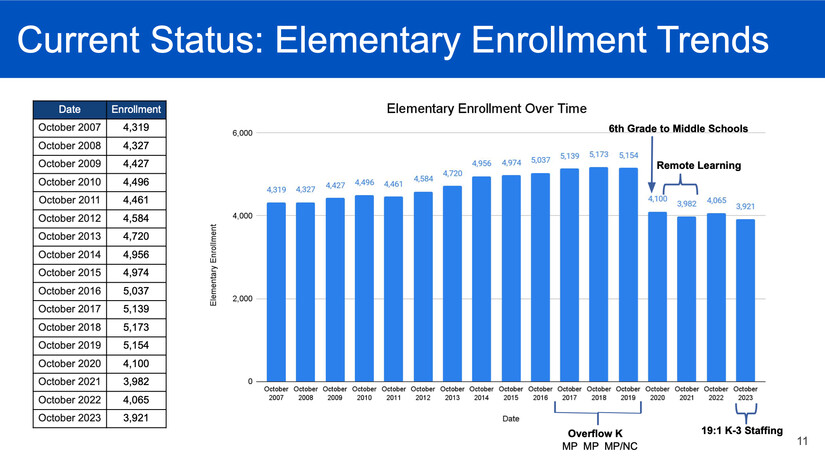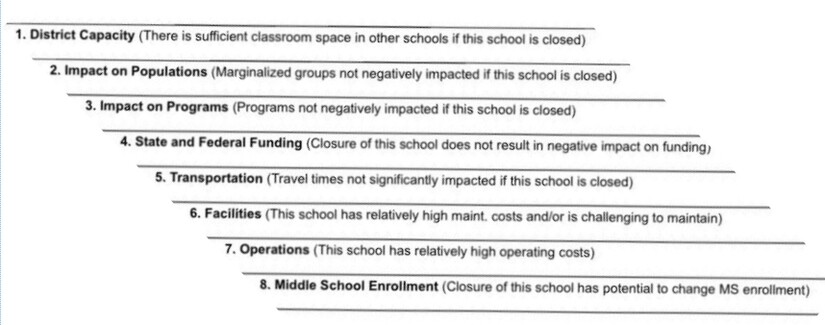Image


School Capacity Review and Closure Consideration FAQ's
After an exhaustive review from all sides during twelve meetings over the course of nine months, a task force consisting of school staff and community volunteers has named Highland Terrace Elementary, the most viable elementary school to recommend for potential closure at tonight's school board meeting.
Here's the schedule of past meetings to arrive at this conclusion:

 Source: SSD412
Source: SSD412Schools need students just like businesses need customers. When there is a lack of customers, companies must take corrective action or go out of business. Enrollment trends have been down since the COVID-19 epidemic and haven't recovered. However, Washington's K-12 schools have also been underfunded for quite some time. On October 23rd, 2024, there will be an Education Funding Crisis Town Hall that some lawmakers will attend.
 Source: SSD412
Source: SSD412Schools have had to be closed in the past; here's the history of closures in Shoreline:
 Source: SSD412
Source: SSD412 Source: SSD412
Source: SSD412 Source: SSD412
Source: SSD412A petition to "Save ALL Shoreline Schools" was started on change.org on Oct 12, 2024, and currently has 797 signatures. One of the claims made in the petition is, "A school closure will result in larger elementary schools and classes, both of which are associated with lower student performance, teacher job satisfaction, and weaker school-family partnerships." to which Shoreline Schools Public Information Officer, Rachel Belfield, counters "the assertion that class sizes will increase with a school closure is untrue. Here's how that's been addressed in our FAQ:
Class sizes will not necessarily increase if a school is closed. In fact, it could alleviate some of the large class sizes seen in the 2023-24 school year, depending on the number of students enrolled in each grade at each school.
Hypothetically, if School A would have 62 fifth graders without a school closure, this would likely result in two classrooms of 31 students, possibly increasing if additional fifth-grade students moved into that school’s boundary during the school year. If School B were closed and School A received 46 fifth graders as a result, this would mean 108 fifth graders at School A, likely split into classrooms of about 27 students each. In this hypothetical scenario, a school closure would result in smaller class sizes at School A."
The change.org petition also states, "A closure will be disproportionately felt by historically marginalized communities, including low-income families, families of color, and families with children who are served on Individualized Education Plans (IEPs) and 504 plans. Closing a school will harm these students, contradicting the school district's commitment to educational equity."
However, Rachel Belfield, Shoreline Schools PIO, further responds, "We understand that change of any sort can be disruptive and challenging for all families, staff, and students, and even more so for historically marginalized groups, who are furthest from educational justice. As the SCRCC task force reviewed data and the implications of closing schools, they were thoughtful in their consideration of all of the students who fit this description, and this led to a few schools being removed from the consideration list due to an attribute unique to each school. There is not one school in Shoreline School District that does not have some students who fit this description and will feel the effect of a school closure more than others; however, the task force ultimately arrived at a recommendation that they felt, if the School Board decides to close a K-5 school starting next year, would have the least negative impact on historically marginalized students.
If a school is closed and we work to support students in their transition to their new school community, we will partner closely with each family and student to consider their needs. Additionally, the district's focus on historically marginalized students and families in the impacted schools would be highly prioritized to minimize, to the extent possible, any negative impacts, including one-on-one meetings with staff from outgoing school to incoming school. IEPs and 504s are legal documents that follow students whenever they move to another school. An IEP/504 team would convene to look over the specific plans, arrange for meetings with families and then again arrange for a IEP/504 meeting with staff and families to ensure the plan will be properly followed for the success of each student in their new school community.
The approximately $1.2 million in cost savings annually that would result from a K-5 school closure would help reduce district expenditures that are outpacing revenue, leading to fewer reductions across the district in other areas, including educational and student supports."
Upcoming Schedule:
If the school board approves a school closure, boundary, transition, and school closure processes will be initiated before the 2025-26 school year.
 Source: SSD412
Source: SSD412
The Edmonds School District is stepping up to address the ongoing education funding crisis by partnering with educators and leaders from the Northshore and Shoreline school districts. Together, they are organizing the Education Funding Crisis Town Hall, a crucial event scheduled for Wednesday, October 23rd, from 6-7:30 p.m. at Edmonds-Woodway High School (7600 212th St. S.W., Edmonds).
This town hall aims to shed light on the pressing issue of underfunding in K-12 education across Washington State. The event will build on the dialogue initiated last year between school district leaders and Washington State legislators. With persistent budget shortfalls continuing to affect local districts, schools, and most importantly, students, the conversation has never been more urgent.
Lawmakers representing the 1st, 21st, 32nd, 44th, and 45th legislative districts have been invited to the town hall, with many already confirming their attendance. This presents a unique opportunity for attendees to hear directly from their representatives about potential solutions to the funding crisis.
Attendees will gain valuable insights into the root causes of K-12 underfunding and its real-world impacts on education quality. More importantly, they will have the chance to engage in meaningful conversations with their legislators, advocating for the financial resources necessary to support students and schools.
The town hall is open to the public, and community involvement is critical to driving change. By attending, you can contribute to the conversation and help push for the funding reforms needed to ensure that Washington State students receive the education they deserve.
Don’t miss this opportunity to make your voice heard and help shape the future of education in our region.